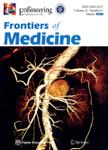Translational initiatives in thrombolytic therapy
Translational initiatives in thrombolytic therapy作者机构:Department of lnWrnal Medicine Division of Cardiovascular Medicine University of Texas Health Science Center at Houston (UTHealth) Houston TX 77054 USA
出 版 物:《Frontiers of Medicine》 (医学前沿(英文版))
年 卷 期:2017年第11卷第1期
页 面:1-19页
核心收录:
学科分类:10[医学]
主 题:thrombolytics nanomedicine plasminogen activators
摘 要:Once thrombi have formed as part of the pathology defining myocardial infarction, ischemic stroke, peripheral arterial disease, deep venous thrombosis or other embolic disorders, the only clinically meaningful thrombolytic agents available for reversing the thrombogenic process are various plasminogen activators. These agents are enzymes that reverse fibrin polymerization underlying the coagulation process by converting endogenous plasminogen to plasmin, which cleaves the fibrin network to form increasingly smaller protein fragments, a process known as fibrinolysis. For the most part, the major clinically used thrombolytics, tissue plasminogen activator, urokinase and streptokinase, as well as the experimentally investigated agent staphylokinase, are the products of recombinant DNA technology, which permits molecular optimization of clinical efficacy. In all cases of molecular optimization and targeting, however, the primary challenge of thrombolytic therapy remains hemorrhagic side effects, which are especially devastating when they occur intracerebrally. Currently, the best strategy to ameliorate this adverse effect is nanoparticulate encapsulation or complexation, and many strategies of this sort are being actively pursued. This review summarizes the variety of targeted and untargeted thrombolytic formulations that have been investigated in preclinical studies.



